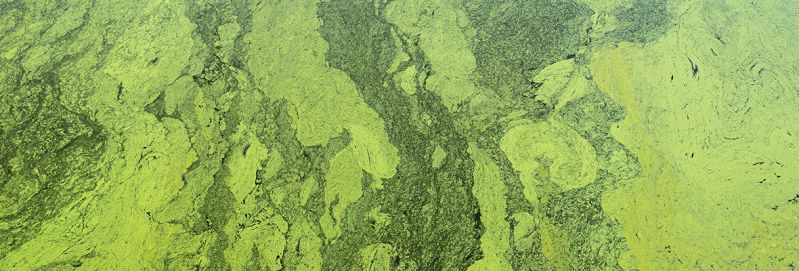Utility Eliminates Bad-tasting Water due to Algae with Advanced Oxidation (Case Study)
Published on by Water Network Research, Official research team of The Water Network in Case Studies
A South Carolina water utility was receiving hundreds of complaints per week about bad-tasting water after algal blooms. Xylem’s advanced oxidation treatment system eliminated the taste and odor issues in the drinking water. The new system also saves the utility $500,000 per year in consumables.

Image of algae oxidation by Xylem
AOP technology is emerging as a new best practice in water treatment. It is particularly attractive to utilities experiencing threats to their source water quality due to nuisance algae issues, which create displeasing taste and odor (T&O) compounds.
The Anderson Regional Joint Water System (ARJWS), a wholesale drinking water provider to 14 water utilities in upstate South Carolina, was recently facing a sizable public relations issue due to ongoing T&O issues in its finished potable water.
ARJWS was receiving numerous complaints about musty-smelling and bad-tasting water after its source water, Lake Hartwell, started experiencing algae issues in 2013. The blue-green algae, or cyanobacteria, produced nontoxic compounds, geosmin and 2-Methylisoborneol (MIB), the sources of the dirty-tasting water.
In-lake algaecide treatments unsuccessful
ARJWS officials tried a variety of solutions, such as copper- or peroxide-based algaecides for in-lake treatment. Adding powder activated carbon (PAC) and chlorine dioxide in the treatment plant to adsorb and oxidize the objectionable compounds did not deliver the desired results, due to the high concentrations of compounds being generated by the algae. Then Lake Hartwell experienced an even larger bloom in 2014, continuing the troubles for ARJWS.
After these methods were unsuccessful, ARJWS directed its engineering consultant Goodwyn, Mills and Cawood (GMC) to explore a treatment system upgrade to eliminate seasonal taste and odor events, remove color associated with naturally occurring iron and manganese, and establish resilience against algae-linked compounds and other contaminants of emerging concern (CECs).
Xylem’s advanced oxidation treatment solution
Through its representative Premier Water, Xylem Inc. teamed up with GMC in 2016 to begin the multiphase process of determining the most viable treatment option in terms of objectives, lifecycle costs and total cost of ownership.
Based on the nature of the contaminants, Xylem designed and executed a treatability study featuring ozone and two other advanced oxidation processes – ozone/hydrogen peroxide, as well as ozone/UV light.
Results of the study indicated ozone alone would be sufficient for most operating conditions and provide the lowest lifecycle cost based on a 20-year evaluation. However, detailed analysis of augmenting ozone with hydrogen peroxide showed that while the lifecycle cost would increase slightly, the ARJWS capital expenditure would be reduced with the use of a smaller ozone contactor basin.
Additionally, ozone AOP was determined to be the most viable overall option because it provided operational flexibility and an additional AOP barrier when needed.
Xylem’s expertise in water treatment solutions, the diligence of the Xylem Wedeco team, and its ability to meet the aggressive spring 2018 schedule set by ARJWS officials made it an excellent partner for the project. In addition to providing the full-scale system, Xylem also ensured optimization of the overall plant upgrade design concurrently with the equipment manufacturing process.
Ozone AOP system eliminates 99.9 percent of algae-linked compounds
In the first six months of operation, MIB and geosmin concentrations in Lake Hartwell were down significantly from previous years, though still at levels detectable by humans. At the start of the algae bloom season, the ozone AOP system eliminated 99.9 percent of the incoming MIB/geosmin, resulting in non-detect values in the outlet. Color has consistently been clear with the increased removal of iron and manganese.
The effectiveness of the pre-oxidation process is bringing considerable operational efficiencies to the clarification and the Xylem Leopold Filterworx system. Additionally, Trihalomethanes (THME) levels were reduced by more than 50 percent due to the ozone treatment and reduced chlorine use.
Average Total Organic Carbon (TOC) removal rates have increased from 35 to 40 percent to 60 to 65 percent, further reducing organic compounds in the finished water, which also aids in reducing post-treatment Disinfectant Byproduct (DPB) formation.
Utility saves $500,000 per year in consumables
With PAC no longer in use, the plant is saving more than $500,000 per year in consumables, plus many operating and servicing hours.
“We consistently went over our $125,000 annual solids removal budget for our onsite lagoons when PAC was used, which also diminishing the available capacity in the lagoons,” says Jennifer Barrington, ARJWS System Engineer. “Those same funds now enable the plant to remove nearly double the solids annually produced.”
Upfront chlorination to keep the media filter cleaner is no longer required, reducing overall chorine use by 50 percent. This results in a savings of about $40,000 to $50,000 annually and is expected to significantly increase the overall life of the chlorine system.
Since the new treatment plant came online, ARJWS has not received a single complaint from any of its 200,000 customers about the water, according to Scott Willett, ARJWS executive director.
The article was originally published on 22 May 2019 in Making Wawes - News from Xylem
Media
Taxonomy
- Drinking Water Security
- Oxidation
- Ozonation
- Drinking Water Treatment
- Polluted Water Oxidation
- Ozone
- Algaecides
- Algae
- Water Utility
- Drinking Water Managment
- Drinking Water
- Utility Pipe Network
- Algae Treatment
- Cell and Molecular biology, Plant biology, Algal biology